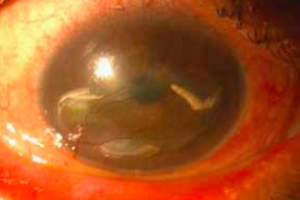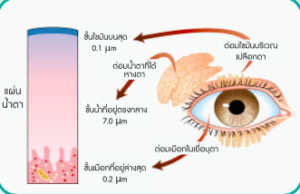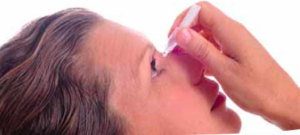By Prof. Somsanguan Asanyakhun
Head of LASIK Center Faculty of Medicine Chiang Mai University
Do you have any of these symptoms?
Burning, irritated eyes, as if there are grains of sand in the eyes, dry eyes, red eyes often, pain in the eyes, tired eyes that can't fight the light, can't fight the wind, blurry eyes, and sometimes tears. need to blink frequently, have mucus in the eye, use a computer for a long time then headache, eye pain Wear contact lenses and have eye inflammation often.
If you have any of the above symptoms Should go and check with an ophthalmologist. whether you have dry eye disease or not
What are the effects of dry eye disease?
Dry eye disease impairs performance. Because when using eyes for a long time, such as staring at a computer screen Dry eye syndrome is an important eye cause of computer vision syndrome (computer-related syndrome) or CVS (CVS).
Burning eyes, can't fight the light, can't fight the wind Make it in a room with a fan on. Or the air conditioner for a long time and uncomfortable in the eyes, red eyes or irritated eyes, burning eyes when driving If a person wears contact lenses Will irritate the eyes while wearing the lens. And there is a chance of infection in the cornea easily
Dry eye disease impairs quality of life. by the moderately dry eye group Quality of life was comparable to that of moderate angina. There may be complications resulting in blindness.

Where are tears made and how does dry eye occur?
Tears are made up of three layers, with the lipid layer at the top, made by the meibomian glands. The middle layer is the aqueous layer, made up of the lacrimal glands in the conjunctiva and the lacrimal glands. This layer contains water, minerals, proteins, and enzymes that nourish the cornea and destroy pathogens. The inner layer is a mucous layer made by the mucous glands in the conjunctiva (globlet cells). These mucus help the tears to adhere to the surface of the eye.

Dry eye syndrome is caused by an insufficient amount of tears that lubricate the surface of the eye. This may be due to less tears being produced. or tears evaporate too much or caused by eye inflammation This can be caused by many factors, including being in an environment with low humidity causing tears to evaporate quickly, such as in a room or car with air conditioning on. Windy place, etc.
Behaviors that reduce blinking of the eyes cause less stimulation to tears, such as staring at a computer screen, reading a book, playing games, or watching television for a long time, etc. and wearing contact lenses, etc.
It also depends on individual risk factors that increase the likelihood of dry eye disease, such as postmenopausal women. the use of certain medications in the eye such as glaucoma medication Or taking drugs that reduce the production of tears, such as antihistamines, nasal decongestants, diuretics, antacids, birth control pills, etc., including diseases that destroy the cells of the lacrimal glands, including autoimmune disease Autoimmune disease, etc., or abnormalities of the eyelids or nerves that prevent the eyes from closing completely. such as toxic thyroid disease Diseases of the nervous system and the brain, etc.
How can I treat and prevent dry eye disease?
There are 3 main treatments and preventions for dry eye disease:
1. Use artificial tears to compensate for inadequate natural tears. along with changing behaviors that cause less blinking, such as resting your eyes from time to time When having to work that requires staring or using eyes for a long time

2. Reduce the evaporation of tears. By avoiding environmental triggers, such as wearing windproof sunglasses when going out if unavoidable. It may be necessary to close the tear holes in some patients with very dry eyes where artificial tears have been ineffective. or eyelid suture surgery in patients who do not close their eyes completely
3. Reduce eye inflammation, e.g. stop wearing contact lenses or treat persistent inflammation of the eyelids
What are artificial tears, how many types, and are they harmful when used regularly?
Artificial tears are lubricants that help moisturize the eye surface. They are divided into two groups: those with preservatives (Preservatives) make the drug last 1 month after opening. There are many types, such as a solution packaged in a bottle, a gel (gel) and a ointment. (ointment) and groups without preservatives It is available as a solution in a small ampoule that must be used within 24 hours of opening or in a special airtight bottle (COMOD system).
There are many types of artificial tears according to their properties. constituent chemicals This is suitable for dry eye conditions of different severity and causes.
Regular use of artificial tears There was no effect on the natural secretion of tears. But there are limitations in use, for example, if it is a type with preservatives Should not be used more than 4 hours as preservatives may harm the eye surface. Makes the more you use it, the more it irritates your eyes. which if you want to drop often Should use the type that does not contain preservatives. which are usually more expensive
If artificial tears must be used in conjunction with other eye drops, such as glaucoma medications Conjunctival allergy medications, anti-inflammatory drugs, etc. should choose to use artificial tears without preservatives. Because there will be no added preservatives that will harm the eye surface. and should be instilled at least 5 minutes away from the original drug, either before or after the original drug
You can contact us for information at the LASIK Center, Faculty of Medicine. Chiang Mai University
Tel. 0-5393-9777 Call center 08-2766-6909 or www.facebook.com/cmulasik
Professor Somsanguan Asankhun
Department of Ophthalmology Faculty of Medicine
Chiang Mai University
